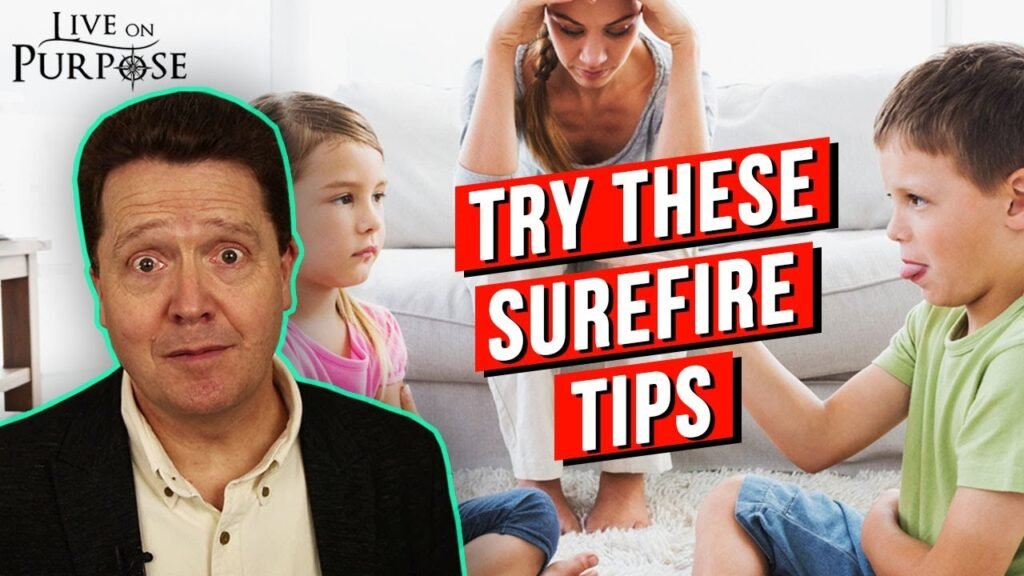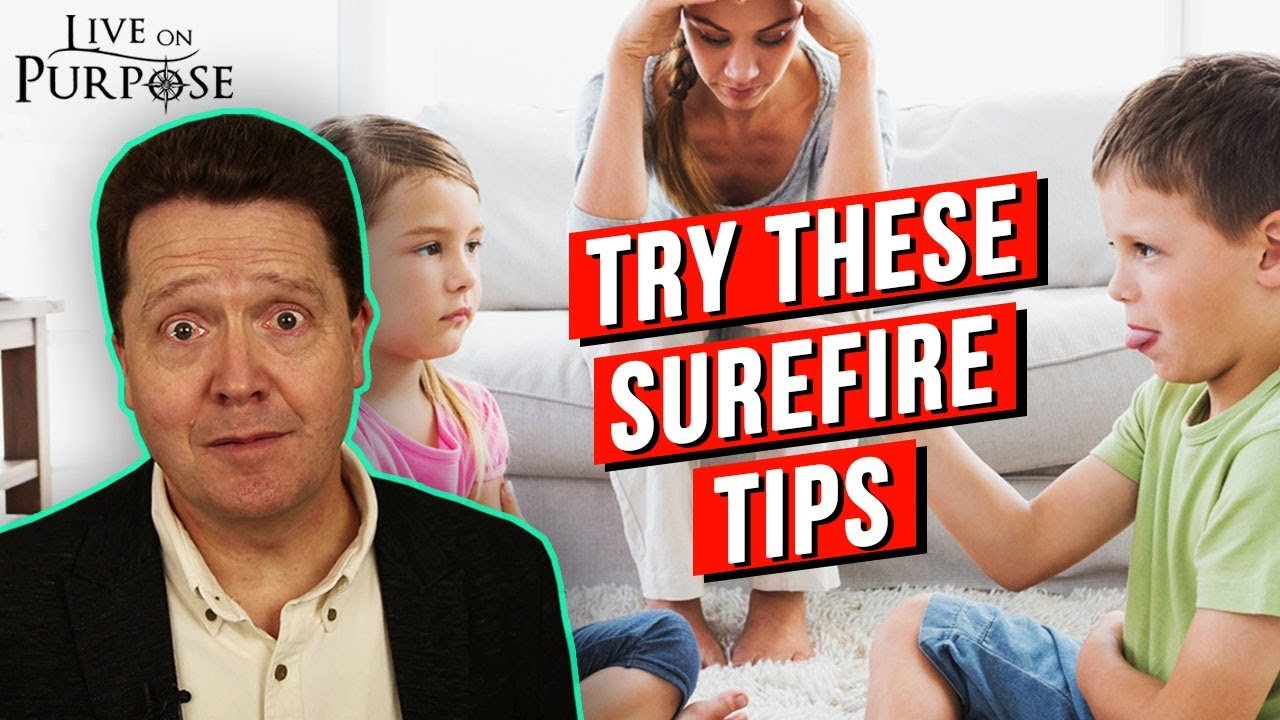Are you a parent struggling with how to handle the frequent fights between your kids? Look no further! In this video by Live On Purpose TV, Dr. Paul Jenkins provides practical tips that will help you effectively manage your children’s fighting. The first tip is to acknowledge that fighting can be potentially dangerous and to intervene before someone gets hurt. It’s important for you, as a parent, to keep your cool and not join in the fight, as getting triggered can make the situation worse. By creating a philosophy of “think, not fight” and encouraging your children to think before acting, you can help them develop better conflict resolution skills. Creating a cool-down period by delaying discussions about the fight can also allow your children to reflect on their actions and make better choices in the future. Additionally, treating your children differently based on their age and stage of moral development, as well as establishing clear family rules and expectations, can prevent fights from happening in the first place. Watch the video and enjoy the valuable insights on positive parenting!
How to Handle Kids Fighting: Practical Tips for Parents

Acknowledge the Potential Danger
As a parent, it’s important to acknowledge that fighting between kids can be potentially dangerous. While most fights are just noise and harmless, there are times when someone can get hurt. It is crucial to intervene and stop the fight before someone gets injured. Remember, your role as a parent is to ensure the safety and well-being of your children.
Stop the Fight Before Someone Gets Hurt
Intervening in a fight may seem obvious, but it is worth emphasizing. As a parent, you play a crucial role in maintaining the physical safety of your children. If you witness a fight, take immediate action to separate the children and prevent any further harm. Remember to prioritize safety above all else.
Stay Calm and Maintain Control
Don’t Join in the Fight
When your children are fighting, it can be easy to get overwhelmed and join in the chaos. However, it is essential to keep your own cool and avoid adding fuel to the fire. Jumping into the fight only escalates the situation and sets a negative example for your children. By staying calm, you create a safe and stable environment for them to learn from.
Avoid Getting Triggered
It’s natural to feel frustrated when your children are constantly fighting, but it’s important not to let your emotions get the best of you. Getting triggered will only make the situation worse and impair your ability to effectively handle the fight. Take a deep breath, step back, and remind yourself to stay calm and collected.
Keep Your Emotions in Check
Your emotions can influence your children’s behavior and reactions. If you become angry or exasperated during a fight, your children may mirror those emotions and escalate the situation further. Practice self-regulation and manage your emotions during these moments. By modeling calm and rational behavior, you can help your children learn to do the same.
Encourage Critical Thinking
Create a Philosophy of “Think, Not Fight”
Promote a culture of critical thinking in your family by encouraging your children to think before engaging in fights. Teach them that violence and aggression are not the solution to their problems. Help them understand the importance of using their words, empathy, and problem-solving skills to resolve conflicts. By fostering a “think, not fight” philosophy, you empower your children to find peaceful resolutions.
Teach Children to Think Before Reacting
In the heat of the moment, it’s common for children to react impulsively without considering the consequences. Encourage your children to pause, take a deep breath, and think before reacting to a conflict. Help them understand the importance of considering the other person’s perspective and finding peaceful resolutions. By teaching them to think before reacting, you instill valuable skills that will serve them throughout their lives.
Delay Discussions and Buy Time
Allow for Cooling Down
After separating your children and halting the fight, it’s important to allow everyone involved to cool down. Emotions may still be running high, making it difficult for a productive conversation to take place. Give everyone the time and space they need to calm down before addressing the situation.
Give Children Time to Reflect
Delaying discussions about the fight provides an opportunity for reflection. When emotions have subsided, encourage your children to think about their actions and consider the consequences of their behavior. This reflection time allows them to take responsibility for their actions and consider alternative ways to handle conflicts in the future.
Postpone Conversations about the Fight
Timing is crucial when discussing the fight with your children. Consider waiting until a more appropriate and calm moment, such as after dinner or before bedtime. By postponing these conversations, you create an atmosphere conducive to learning and growth. It also allows you, as a parent, to gather your thoughts and approach the discussion with clarity.
Consider Age and Moral Development
Treat Children Differently Based on Age
Every child is unique, and their responses to conflicts may vary based on their age and understanding. It is essential to recognize these differences and tailor your approach accordingly. Adjust your expectations and methods of intervention based on their age, ensuring that you address their needs and level of understanding.
Understand the Stage of Moral Development
Children go through different stages of moral development as they grow. Familiarize yourself with these stages to better understand your child’s perspective and behavior. By understanding their moral development, you can provide appropriate guidance and support. Remember to be patient and meet them where they are in their development.
Avoid Negative Comparisons
When dealing with multiple children involved in a fight, it’s important to avoid negative comparisons. Negative labels and comparisons hinder your children’s growth and can damage their self-esteem. Instead, focus on understanding each child’s unique circumstances and addressing their individual needs. Treat each child in a manner appropriate to their stage of development without making unfair comparisons.
Be Observant and Gather Information
Understand the Pre-Fight Context
Fights rarely happen out of nowhere. There is usually a context or trigger that leads to the conflict. Pay attention to the events leading up to the fight, as it can provide crucial information about the underlying issues. By understanding the pre-fight context, you can better address the root causes and implement appropriate interventions.
Determine Appropriate Consequences or Interventions
Once you have a clear understanding of the situation, it’s important to determine the most effective consequences or interventions. Consider the severity of the fight, the underlying causes, and the children involved. Tailor your response to promote learning, growth, and positive behavior. It may be helpful to consult resources or seek guidance from professionals in child development if needed.
Establish Clear Family Rules and Expectations
Respect Oneself and Others
Establishing clear family rules and expectations is crucial in preventing fights. One of the fundamental rules is respect for oneself and others. Teach your children the importance of treating others with kindness, empathy, and respect. By instilling this value, you create a foundation for peaceful interactions within the family.
Respect Property
Respect for property is another important rule to emphasize. Teach your children to take care of their belongings and respect the property of others. By fostering a sense of responsibility and ownership, you reduce the likelihood of conflicts arising from issues related to property.
Cooperate and Obey
Encourage your children to cooperate and obey as part of your family rules and expectations. Cooperation involves actively working together to find solutions and collaborating in a positive manner. Additionally, teaching your children to obey authority figures helps establish boundaries and fosters a harmonious family environment.
Foster Communication and Conflict Resolution Skills
Teach Effective Communication
Effective communication skills are essential in resolving conflicts. Encourage your children to express their feelings and needs openly and honestly. Teach them active listening by paying attention to each other’s perspectives and showing empathy. By promoting effective communication, you provide a valuable tool for resolving conflicts peacefully.
Encourage Problem-Solving
Problem-solving is a critical skill that empowers children to find peaceful resolutions. Encourage your children to brainstorm solutions, consider alternatives, and evaluate the consequences of their actions. By teaching problem-solving skills, you equip your children with tools to navigate conflicts successfully.
Promote Empathy and Understanding
Empathy and understanding are crucial for resolving conflicts and strengthening relationships. Help your children develop empathy by encouraging them to consider other people’s feelings and perspectives. Teach them to put themselves in other people’s shoes and understand the impact of their actions. By promoting empathy, you create a foundation for peaceful interactions and conflict resolution.
Provide Emotional Support and Guidance
Validate Feelings and Emotions
When addressing fights between your children, it is important to validate their feelings and emotions. Let them know that it is normal to experience anger, frustration, or other intense emotions. By acknowledging their feelings, you create a safe space for them to express themselves and promote open communication.
Help Children Identify Their Needs
Fights often arise from unmet needs or misunderstood intentions. Help your children identify their underlying needs and encourage them to communicate them effectively. By understanding and addressing their needs, you can work towards resolving conflicts more effectively.
Teach Healthy Expression of Emotions
Provide guidance on healthy ways to express emotions. Teach your children alternative ways to express anger, frustration, or sadness that do not involve physical violence or aggression. Encourage them to use words and communicate their emotions constructively. By teaching healthy expression of emotions, you equip your children with lifelong skills for emotional regulation and conflict resolution.
Conclusion
Handling fights between your children can be challenging, but with the right approach, it is possible to promote peaceful resolutions and foster positive relationships. By acknowledging the potential danger of fights, staying calm, encouraging critical thinking, delaying discussions, considering age and moral development, observing and gathering information, establishing clear family rules, fostering communication and conflict resolution skills, and providing emotional support and guidance, you can navigate these situations with confidence and promote a harmonious family environment. Remember, your role as a parent is to guide your children towards peaceful resolutions and help them develop the necessary skills for handling conflicts throughout their lives.

